Landmarks and Monuments of Florida State University
The Landmarks and Monuments of Florida State University are monuments and landmarks located on Florida State University's Tallahassee campus that are considered culturally or historically significant. The landmarks usually depict a person in the history of the university or represent an ideal that the university holds. These landmarks can also represent a key part of traditions held by the student body.
Landmarks and Monuments at Florida State
| Name | Picture | Date Established | Summary |
|---|---|---|---|
| Integration Statue | 2004 | At the center of campus, the statue celebrates 50 years of Florida State being an integrated school for African American and Caucasian students. The Florida State University Integration Statue is a monument at the center of the university's Tallahassee campus depicting three notable students in the schools integration of African American students. The monument features three nine foot bronze statues of former students Fred H. Flowers, Doby Lee Flowers, and Maxwell Courtney standing together on a circular pedestal made from brick.
The Monument was created by W. Stanley Proctor starting in the 1980s and unveiling the finished monument at Florida State's "Heritage Day" celebration on January 30, 2004. Proctor's intention was to depict all aspects of student life at the university and based his final sculpting on the concept of "books, bats, and beauty". He did this by depicting each statue in a different way, with Fred H. Flowers being depicted in his baseball uniform to represent athletics, Doby Lee Flowers depicted in her Homecoming queen uniform to represent social, and Courtney depicted holding an America History textbook to represent academics. | |
| Langford Green | 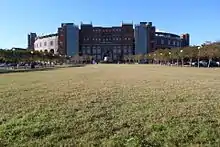 Green in front of Florida State University's Doak-Campbell Stadium on their Tallahassee campus. |
1950 | Open green venue situated in front of the Doak Campbell Stadium. Situated in front of the Doak Campbell Stadium on the campus, the Langford Green serves as a venue for performances and speeches, including concerts and similar events that are not organized by the University. The prime location of the venue allows for a fair number of spectators. |
| Landis Green | 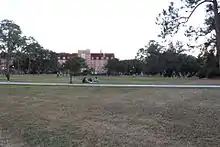 A green at Florida State University's Tallahassee campus used by students for recreation and events. |
1931 | Rests in the center of the campus as a student hub and area for recreation. Located in the center of the Florida State campus, Landis Green rests in front of the Landis Hall dormitory. Both hold their names after Cary D. Landis, who served as the Attourney General for Florida from 1931-1938. The Green serves as both an aesthetic piece to the campus and as a location for student recreational activities throughout the year. Within the Green is the Legacy Fountain that saw construction in 2005, much later than the establishment of the green in 1931, though the green did not see its formal name until 1936. The University's Strozier Library rests opposite from the dormitory on the other end of the green, allowing the green to act as a further hub for students and faculty. |
| Legacy Fountain | 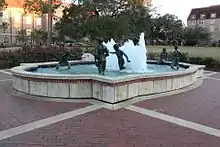 Popular fountain on the Florida State University Tallahassee campus. |
2005 | Commemorating the culture of when the University was a women-only campus. Legacy Fountain is located on Landis Green in the center of Florida State University's campus, and has been there since its dedication on January 28 of 2005. It was created by a former Florida State University student, Edward Jones, who graduated with a bachelor's degree in Fine Arts, and has also created other sculptures on campus such as the Francis Eppes monument and the Sportsmanship statue. It contains six life size bronze women statues that represents the university's heritage, as it used to be a woman only student body from 1915 until 1947, and their outfits reflect the fashion from that time.[1] The statues are fixated in a fountain full of water that is meant to be used as a reflection pool to think about the roots of the school. The fountain is located next to Landis Hall, which was built during 1939 when Florida State University used to be a women's college which is the reason for Legacy Fountain's location. Along the side of the fountain are five bronze plaques that tell parts of the University's history, and on the floor of the fountain are two University seals on each respective side. |
| Mina Jo Powell Alumni Green | 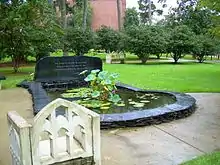 Student Government monument |
2000 (formal name received) | Served as the sole stage for commemoration until 1950, named in 2000 for a former alumni. The Mina Jo Powell Alumni Green is a half-acre area of land was dedicated to FSU alumni Mina Jo Powell by FSU President Bernard Slinger. The site originally was meant for the University's commencement ceremonies until 1951, where a larger student body demanded more areas available. |
| Unconquered Statue | 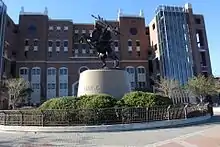 Statue in front of Florida State University's Doak-Campbell Stadium on their Tallahassee campus. |
2003 | Statue depicting the mascot and symbol of Florida State University, Seminole Chief Osceola. Fixated in front of the main gates of Florida State University's Doak Campbell Stadium, the Unconquered Statue provides students and fans alike with a sense of pride for the University. In 1962, Bill Durham proposed a tradition in which a student would dress as a Native American, mount his horse and lead the team into a clash with their weekly football rival.[2] Supported by the Seminole tribe, the duo of Chief Osceola and his horse Renegade has become an icon at Florida State. The statue is of the two, with Chief Osceola holding the spear high above his head. The night before every home football game, the flame at the end of the spear is ignited. The flame stays lit until the conclusion of the game the following day. The development of the statue is credited to Steve Reilly. The statue was not designed to represent any specific historical figure or event, but instead serves as a symbol of the unconquered nature of the university. The statue stands thirteen and a half feet tall, and sits atop a seventeen and a half foot base. |
| Union Green | 1952 | Frequent area of university events and demonstrations outside the student center. This area outside the Oglesby Student Union of the campus is the smallest of the plots on campus, but due to its location sees a proportionally great amount of foot traffic with the university using the area for many special events. Due to the limited space available to the green, it has seen different use from the other open spaces on campus in that instead of recreational activities, more formal events take place. Student demonstrations, university fairs, and promotional events are all prominent examples of what the union green sees regularly.[3] | |
| Westcott Fountain | 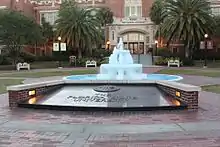 A well known fountain on Florida State University's Tallahassee campus. |
1917 | In front of the main gate of the campus, the fountain acts as a symbol of the University and a key decoration to visitors. Westcott fountain gets its name from the building that it resides in front of, the Westcott building, former location of what was known as Gallows Hill in the 1830s.[4] The fountain was put into its current location in 1917, and it was a gift from the 1915 to 1917 classes.[5] The fountain was renovated in 1982 in remembrance of Professor Anna Forbes Liddell (1891-1979), a Robert O. Lawton Distinguished Professor of Philosophy.[6] The Westcott fountain is also accompanied by the Brick plaza around it which was a project in 1996 and 1997 classes.
The bricks around Westcott fountain now contains names of students who has graduated from Florida State University. The Brick Program is administered by the FSU Alumni Association. Due to the long history of Westcott fountain in Florida State University, the university advertises Westcott fountain as one of the most significant locations on campus. The Westcott Fountain also holds a tradition among students that on a person's twenty-first birthday they are dunked in the fountain. It is also popular for students to take their graduation pictures at the fountain. |
References
- "FSU's Monuments and Memorials: The Legacy Fountain". myweb.fsu.edu. Retrieved 2016-11-21.
- "Unconquered Statue". Seminoles.com. Retrieved 2016-11-21.
- "Oglesby Union / About Us / History of the Oglesby Union Complex". union.fsu.edu. Retrieved 2016-11-21.
- Davis, Hannah Wiatt. "School Spirits: Ghosts at Florida State." FSU Special Collections. N.p., n.d. Web.
- "FSU's Monuments and Memorials: Westcott Fountain." Exploring FSU's Past. N.p., n.d. Web. 20 Nov. 2016.
- "Westcott Fountain and Plaza." Legacywalk. N.p., n.d. Web.